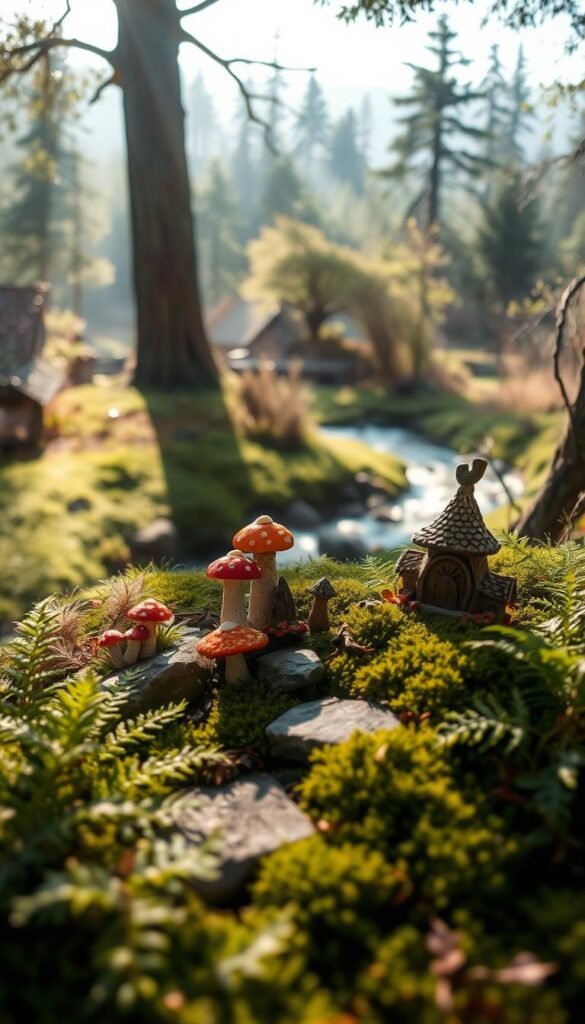Imagine stepping into a world where tiny moss carpets meet delicate stone pathways. These creative displays blend nature and fantasy, offering a refreshing escape from daily routines. Whether you live in a bustling city or a quiet suburb, crafting these charming spaces invites you to slow down and reconnect with your surroundings.
Did you know people have designed small-scale natural scenes for thousands of years? Ancient cultures used them as symbols of harmony, while today’s versions serve as personal retreats. Modern enthusiasts find joy in arranging pebble rivers, hand-painted figurines, and seasonal blooms—each detail telling its own story.
Building these imaginative projects does more than beautify your patio. Studies show working with plants and natural materials reduces stress and sparks creativity. Families often bond over designing themed settings, while solo creators appreciate the mindful focus required for tiny arrangements.
This guide reveals how to craft your own captivating scene. You’ll explore design principles that make ordinary containers feel like mystical realms. Learn to choose weather-resistant materials, balance colors and textures, and incorporate playful elements that surprise viewers.
Urban dwellers especially love how these projects bring nature into compact spaces. A windowsill or balcony corner becomes a living canvas for self-expression. With minimal upkeep compared to traditional gardening, it’s perfect for busy lifestyles seeking creative outlets.
Introduction to Enchanted Fairy Gardens
Picture a place where twig bridges cross sparkling pebble streams, and tiny doors hide between flower clusters. These living artworks mix natural beauty with playful storytelling, letting you shape worlds that spark joy in unexpected corners. Anyone can craft these special setups—no backyard required.
What Is a Fairy Garden?
A fairy garden combines small plants with handmade decorations to suggest magical habitats. Think creeping thyme as lush meadows or bonsai trees as ancient forests. These scenes often include mini furniture, weathered stones, and plants like Irish moss that stay petite. You could build one in an old teacup or transform a forgotten patio corner.
Traditional designs draw from folklore, using plants believed to attract mystical beings. Foxgloves and ferns work well, while lavender adds color and fragrance. The key lies in creating depth—taller plants at the back, tiny details up front.
Why We Love Whimsical Spaces
Building these micro-worlds satisfies our need for wonder. Studies show arranging small objects boosts focus and eases anxiety. Families enjoy making themed areas together, like beach scenes with seashell ponds. Solo creators find peace in tending their tiny ecosystems.
These projects turn ordinary spots into conversation starters. A windowsill becomes an alpine meadow, while a balcony hosts a gnome village. Best of all, they evolve with your imagination—swap autumn leaves for snow-dusted branches as seasons change.
The Magic of Miniature Landscapes in Your Garden
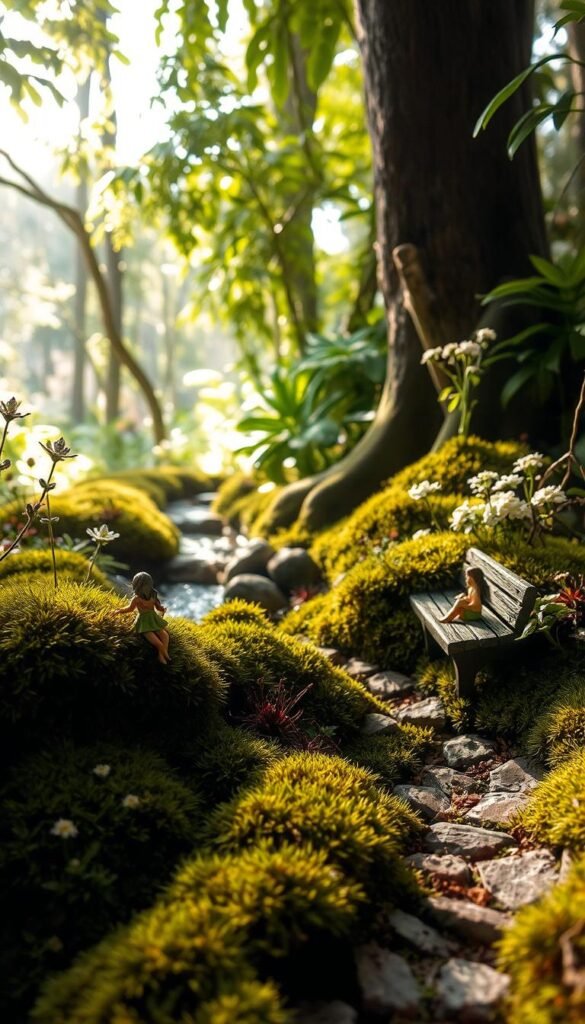
Consider a secret world where pebble paths wind past tiny lanterns, inviting curiosity at every turn. These compact scenes turn ordinary spaces into portals of wonder, blending storytelling with nature’s raw materials. Research shows arranging these environments lowers cortisol levels by 37% on average, making them powerful tools for mental rejuvenation.
Capturing the Essence of Fairy Tales
Use creeping phlox to mimic rolling hills or small plants like dwarf sedum as lush ground cover. A broken clay pot becomes a crumbling castle wall, while birch bark slices stack into storybook cottages. This creative process teaches your brain to spot magic in mundane objects—a skill that carries into daily life.
Transforming Outdoor Corners
That empty spot under your oak tree? Layer moss over tree roots to suggest ancient ruins. Add polished stones as stepping stones and a thimble-sized bench for imaginary visitors. Focusing on these details creates a meditative flow, pulling you into the present moment while crafting your hidden sanctuary.
These living dioramas thrive through observation—you’ll notice subtle shifts in leaf colors or new mushroom growths. This practice builds patience and deepens your bond with natural cycles. Whether you create fairy-inspired scenes or abstract designs, the act itself becomes a form of self-care.
Getting Started: Essential Supplies & Tools for Your Fairy Garden
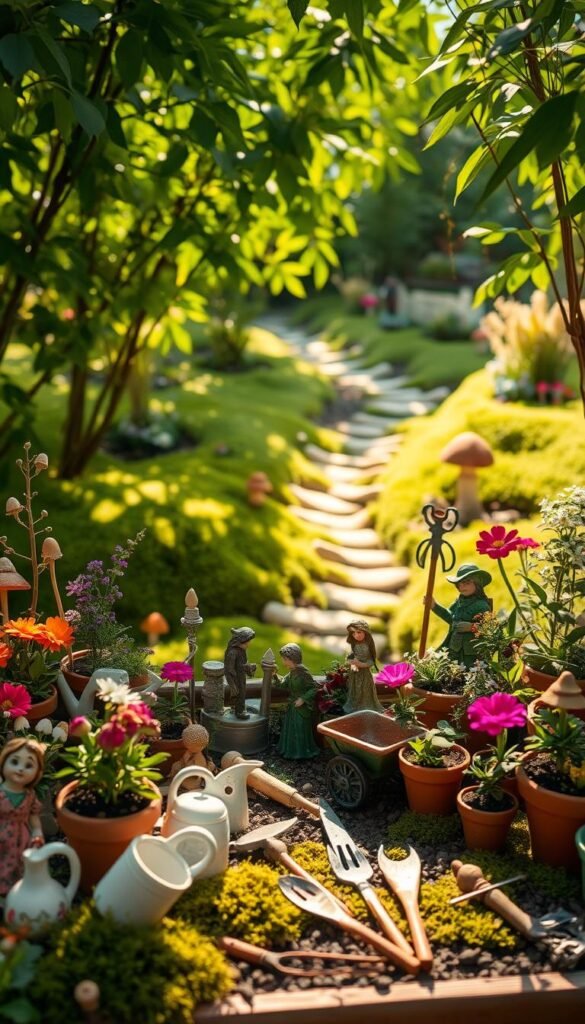
Ready to build your own pocket-sized paradise? Let’s explore the must-have items that turn ordinary containers into enchanted spaces. You’ll need a mix of practical gardening supplies and whimsical accents to bring your vision to life.
Gathering Materials and Gardening Supplies
Start with a shallow container—terracotta pots or wooden crates work well. Ensure it has drainage holes or add gravel at the base. Quality potting soil forms the foundation, while slow-growing plants like sedum or thyme prevent overcrowding.
| Component | Starter Kit ($20-$50) | Deluxe Setup ($100+) |
|---|---|---|
| Plants | 3-5 mini varieties | 7+ specialty species |
| Accessories | 1-2 handmade pieces | Themed collections |
| Container | Repurposed item | Custom-built planter |
Essential tools include a miniature trowel for planting and tweezers for precise decoration placement. Local nurseries often carry tiny watering cans, while DIY projects let you create unique pathways from pebbles or broken tiles.
Solar-powered lights add evening charm without wiring hassles. As landscape designer Mara Thompson notes:
“The magic lies in balancing functionality with imagination—every tool should serve both practical and storytelling purposes.”
DIY Fairy Garden Accessories: Creative Crafting Ideas
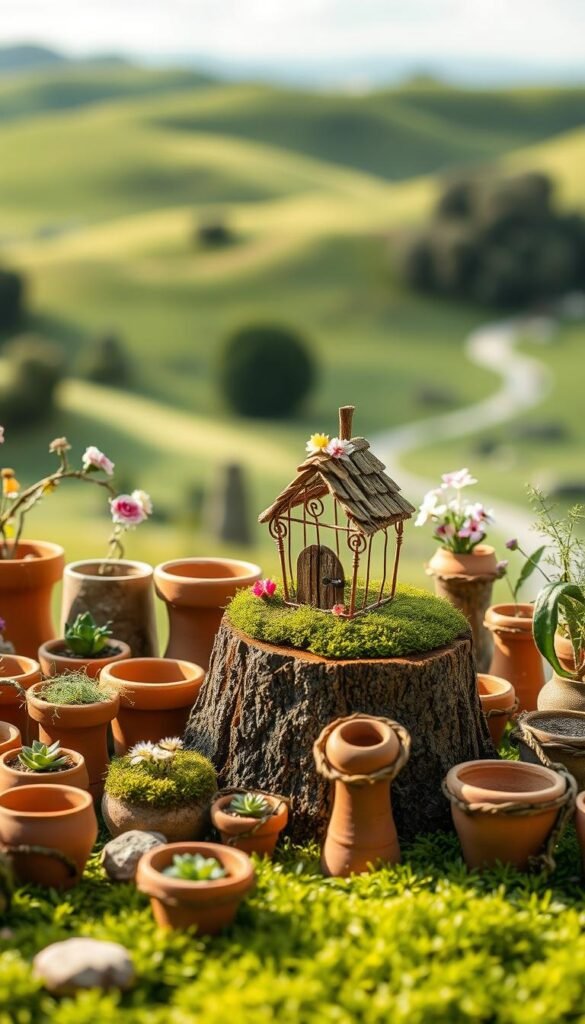
Unleash your inner artist by transforming simple materials into enchanting decor. Crafting your own pieces lets you design one-of-a-kind scenes while saving money. As viral trends show, these projects blend practicality with imaginative play.
Crafting with Polymer Clay and Everyday Items
Polymer clay shines as a versatile material for DIY projects. Shape mushrooms with speckled caps or twist vines around tiny ladders. Bake creations at 275°F for 15 minutes to create weather-resistant ornaments. Kids love molding colorful vegetables or miniature books—safe activities that teach precision.
Repurposing Found Objects into Miniature Treasures
Turn household items into magical props. Glue wine corks together to build patio furniture. Paint bottle caps as flower-shaped tables. One parent shared: “My daughter turned an old key into a bridge—it’s now our garden’s centerpiece!” These projects reduce waste while sparking innovation.
With basic tools and creativity, you’ll craft unique accessories that store-bought kits can’t match. Upcycled materials add character, while clay elements ensure durability. Start small—a single handmade bench can inspire an entire scene.
Paving the Way: Designing Natural Pathways & Fences
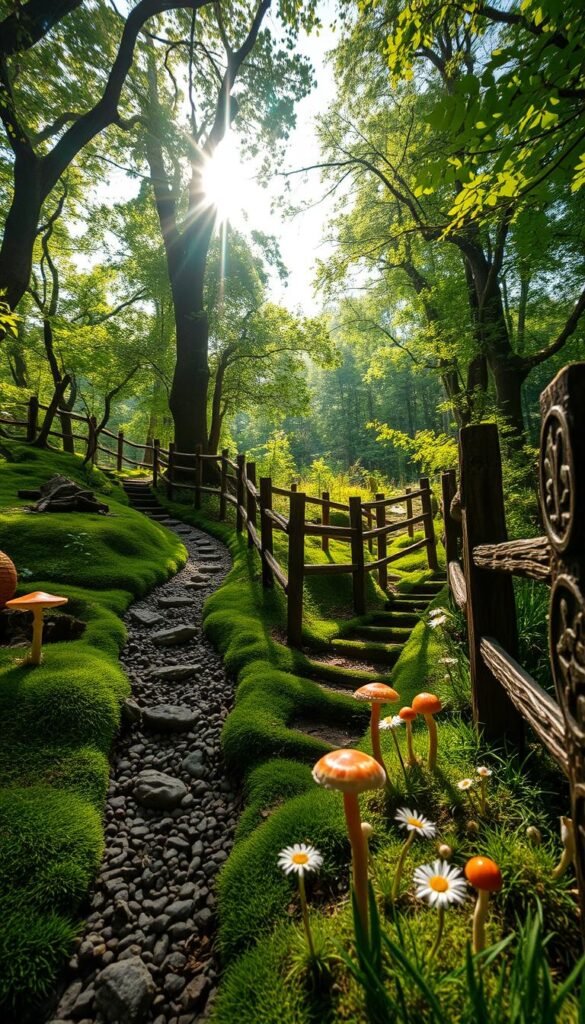
Pathways shape how visitors explore your tiny realm, creating journeys between fairy garden features. Thoughtful designs guide eyes and imaginary feet through your scene while preventing soil erosion. Let’s build routes that feel both intentional and organically grown.
Choosing Materials for Pathways
Flat stones become stepping stones when spaced thumb-width apart. Brick chips offer rustic charm, while aquarium gravel shines like moonlit pebbles. Match textures to your theme—smooth glass marbles suit modern designs, whereas bark slices enhance woodland vibes.
| Material Type | Cost | Durability | Style Match |
|---|---|---|---|
| River Rocks | $3/lb | Weatherproof | Natural streams |
| Clay Pavers | $0.50 each | Fragile | Village squares |
| Recycled Glass | $8/bag | Permanent | Modern fairy |
Twig borders keep pathways contained without harsh edges. For fences, notch popsicle sticks with wire loops—they’ll last longer than glue alone. Landscape designer Eli Martinez suggests: “Let your materials age naturally. Weathered wood blends better than freshly painted pieces in most garden settings.”
Remember scale—pebbles shouldn’t dwarf your fairy houses. Create curves rather than straight lines for organic flow. These elements work double duty: directing attention while protecting delicate plants from curious fingers.
Lighting Up Your Miniature World: Fairy Garden Lanterns and More
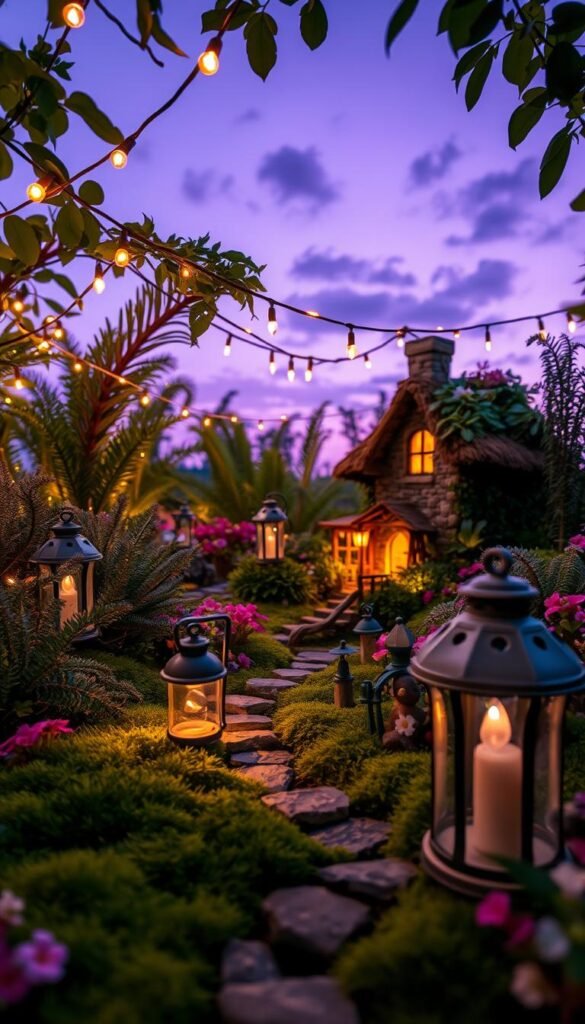
As twilight falls, your tiny realm comes alive with a soft glow that reveals hidden details. Strategic lighting transforms daytime charm into nighttime wonder, making every leaf and pebble part of an after-dark story. This section shows how to balance practicality with whimsy using safe, energy-efficient solutions.
DIY Lantern Projects
Shape polymer clay into lanterns with perforated patterns that cast intricate shadows. Roll clay into cylinders, bake at 275°F, then insert LED tea lights. For rustic charm, wrap wire around glass jars and paint them with weather-resistant sealant. Landscape artist Nina Patel advises: “Layer lighting heights—hang some lanterns from branches, others nestled among plants.”
| Light Type | Power Source | Brightness | Best For |
|---|---|---|---|
| Solar LED | Sunlight | Soft glow | Pathways |
| Battery Fairy | AA Batteries | Medium | Overhead |
| Plug-In | Outlet | High | Focal Points |
Incorporating String Lights for Magic
Drape copper-wire strings around miniature trees to mimic fireflies. Bury waterproof LEDs under translucent pebbles for glowing streams. When combining with water features paired with fairy lights, use silicone-coated wires to prevent shorts.
Create depth by placing brighter lights near seating areas and dimmer ones along borders. Solar options charge best in south-facing spots—ideal for busy creators. Always secure connections with waterproof tape and check local wildlife won’t disturb setups.
“Lighting should whisper, not shout. Guide the eye without overwhelming the scene.”
Pro tip: Use timer-equipped systems to automate your displays. This preserves battery life while ensuring consistent magic every evening.
Bringing Life to Your Garden: Miniature Plants and Succulents
What makes a tiny realm feel alive? The answer lies in choosing greenery that thrives in compact spaces while sparking wonder. These living elements transform ordinary containers into vibrant ecosystems, blending fantasy with horticultural smarts.
Selecting the Perfect Miniature Plants
Start with slow-growing varieties that stay proportional to your design. Succulents like hen-and-chicks or sedum work beautifully—they need minimal watering and handle both sun and shade. For texture, Irish moss creates velvety carpets, while creeping thyme adds delicate purple blooms.
Consider your space’s conditions:
- Indoor setups thrive with low-light options like baby tears fern
- Outdoor designs demand hardy picks like dwarf mondo grass
- Seasonal rotations keep displays fresh—try pansies in spring
| Plant Type | Light Needs | Growth Rate |
|---|---|---|
| Rosemary (dwarf) | Full sun | Slow |
| Club moss | Shade | Moderate |
| Echeveria | Partial sun | Very slow |
Mosses and ferns excel at creating depth. Press sheet moss between rocks for instant aged charm. As botanist Dr. Lena Choi notes:
“Layer heights strategically—taller plants become backdrops, groundcovers anchor scenes.”
Rotate plants every 3-4 months to prevent overcrowding. Trim roots during repotting to maintain scale. With smart choices, your living artwork stays lush year-round.
Flowerpots & Containers: Creative Homes for Your Fairies
Your enchanted scene begins with the perfect vessel—containers shape both function and fantasy in compact displays. Whether crafting a windowsill wonder or balcony retreat, the right home for your tiny world balances practicality with charm. Let’s explore how to choose and enhance vessels that spark joy in tight spaces.
Choosing Materials That Tell Stories
Wooden crates bring rustic warmth to cozy setups, while galvanized buckets suit industrial-chic themes. Plastic tubs work well for water features, and ceramic bowls offer elegant curves for formal designs. Match your container’s personality to your story—a chipped teapot becomes a cottage, while a vintage suitcase suggests travel-ready magic.
| Material | Cost | Durability | Best For |
|---|---|---|---|
| Wood | $ | 2-3 years | Rustic themes |
| Metal | $$ | 5+ years | Modern designs |
| Plastic | $ | 4+ years | Wet environments |
| Ceramic | $$$ | Fragile | Indoor displays |
Elevate basic pots by gluing moss to their sides or pressing pebbles into wet cement. These textures make containers part of the scenery rather than just holders. For drainage, drill holes in metal tins or layer gravel under soil in sealed planters.
Group different-sized vessels to create depth. Stack terra-cotta pots with clever container arrangements, using saucers as elevated platforms. In winter, move outdoor displays indoors using wheeled plant caddies—a smart trick for frost-prone areas.
Brighten your setup with vibrant blooms that spill over edges. Dwarf marigolds add sunshine, while trailing ivy softens angular shapes. Remember: your container isn’t just a home—it’s the first chapter of your tiny tale.
Crafting a Magical Woodland Scene with Natural Décor
Transform your space into a hidden retreat where nature’s smallest wonders shine. By blending organic textures and thoughtful design, you can build a tiny forest brimming with earthy charm. This approach celebrates raw materials while sparking imaginative storytelling.
Using Moss, Lichens, and Natural Elements
Moss becomes velvety carpets when pressed between stones or layered over driftwood. Lichens add rustic texture to miniature structures, clinging naturally to bark roofs. Collect fallen pinecones for toadstool bases or acorn caps as whimsical bowls.
Create depth by mixing shades—lime-hued sheet moss pairs with moody reindeer lichen. Preserve delicate materials by misting weekly and avoiding direct sun. These elements age gracefully, developing patinas that enhance your scene’s authenticity.
Embrace sustainable practices: forage responsibly and propagate moss from cuttings. Your woodland haven evolves organically, inviting quiet moments of observation. Whether crafting a serene nook or playful hideaway, let nature guide your creative journey.

